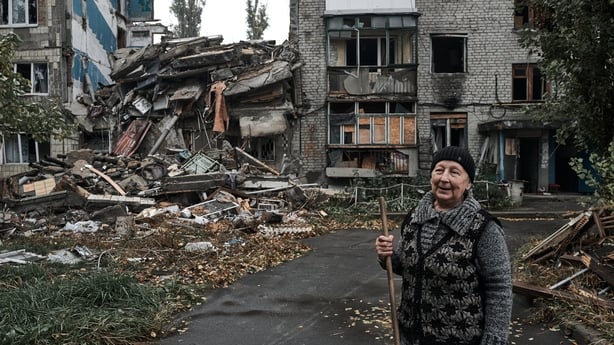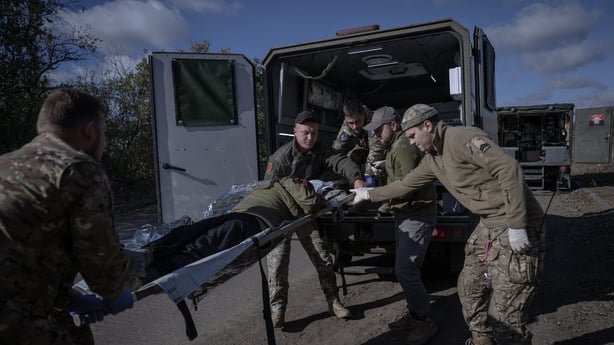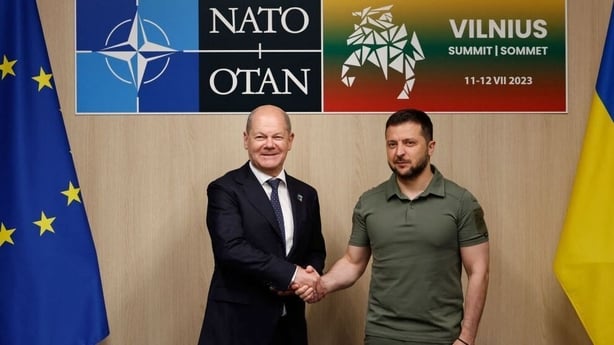Ukraine's counteroffensive, which was launched in early June, continues at a slow, grinding pace along a 1,000km frontline.
And, as winter approaches, Russia still occupies similar frontline positions from those held five months ago.
Since 10 October, Russian forces launched two large mechanised attacks on Avdiivka, a town 15 kilometres west of Donetsk, a city occupied by Russia.
Ukraine's military said on Thursday that 5,000 Russian troops had been killed or wounded and more than 400 Russian armored vehicles lost in its assault on Avdiivka, figures that are difficult to independently verify.
Avdiivka is important to Russian forces because its main road leads directly to Donetsk city and is known in Ukrainian circles as the 'gateway to Donbas'.
"It will be very similar to Bakhmut, trying to strike Ukrainian positions with artillery, building by building," Mykhailo Samus, a Kyiv-based defence analyst, told RTÉ News.
"It's obvious that Avdiivka will be destroyed."
Prior to Russia’s full-scale invasion last year, the Ukrainian army and Moscow-backed separatists had fought for control of the town for eight years. It was one of the bloodiest engagements in Moscow’s previous proxy war against Kyiv.
But the town has always remained in Ukrainian hands.
In doing so, Ukrainian forces have been able to keep Russian forces near Donetsk within artillery range, preventing Moscow from turning the area into a key military hub on the eastern front.
Just over 1,000 civilians, many of whom are elderly, remain in what is left of the town.
Avdiivka had a pre-war population of more than 30,000.

"It's a place that the Russians have struggled to advance before and throughout the war," Riley Bailey, a Russia analyst at the Institute for the Study of War (ISW) in Washington DC, told RTÉ News.
ISW studies open source accounts of frontline activity published by official Ukrainian and Russian sources and issues daily reports on the fighting.
Mr Bailey said that initially the Russian attack on Avdiivka looked like "a localised offensive" and could be an effort to draw Ukrainian forces to the sector, a tactic that Russian commanders used previously in Bakhmut and the Zaporizhzhia region.
During almost five months of counteroffensive operations, Kyiv’s forces have recaptured hundreds of square kilometres, mostly villages in both the east and southern theatres of combat.
This pales in comparison to the 6,000 square kilometres that its forces recaptured during a rapid offensive in the south of the country in September 2022.
Russia has built strongly fortified defences, layered with mines along the entirety of the front.
In particular, the Zaporizhzhia region in the south is heavily mined.
And though Ukrainian forces south of Kherson city have established a thin bridgehead along the eastern bank of the Dnipro river, they have so far struggled to push farther south.
During winter, the Dnipro river will freeze, making it easier for Ukraine's marine units to launch operations over to the east bank.
"We need to get through Russian defence lines to Tokmak, and after Tokmak there could be an operational space for new success," said Mr Samus, director of the New Geopolitics Research Network, a Kyiv-based think tank.
Tokmak is a small city in the Zaporizhzhia region, currently within Russia’s zone of occupation and about 40km south of the frontline on the Dnipro river.
The Royal United Services Institute in London assesses that a Ukrainian breakthrough towards Tokmak is "highly unlikely" by the end of this year unless Russian forces decide to withdraw.

Ukraine's military strategy is to cut the Russian area of occupation in two, thereby creating two separate theatres of combat, which would be easier to whittle down.
The problem, however, is that Kyiv lacks air superiority.
Denmark, the Netherlands and Norway have agreed to supply Ukraine with F-16 fighters by early next year.
And Ukrainian pilots are currently being trained in the United States to fly F-16s, hardware that Ukraine’s President Volodymyr Zelensky had spent most of 2023 demanding from many NATO member states.
The slow, attritional nature of the fighting along Russia’s heavily mined lines of defence has meant that Ukraine has so far been unable to unleash the full potential of Western-supplied Leopard II tanks, known for their speed and robust mobility.
Drones too, used by both sides, have hampered the use of tanks in the war.
Tank columns can be easily spotted by drones and targeted by artillery. Ukrainian forces used this tactic to lethal effect on Russian tank columns outside Kyiv during the first phase of the war.
The onset of winter, for the second time in this war, does not mean there is going to be a lull in the fighting.
During eastern Europe’s freezing winter weather, the ground hardens, making it possible for mechanised manoeuver warfare, said Mr Bailey.
So tank warfare could still take place this winter if Ukrainian forces can somehow smash through Russia’s first layer of defence.
Taras Berezovets, a captain and press officer with Ukraine’s Special Forces, told RTÉ News that more offensive operations by the Ukrainian army would take place in the coming months.
Speaking by phone from the eastern front, he said his unit was "looking forward to the winter campaign" and that the current counteroffensive has been "quite successful".
Some outside observers are less sanguine.
"Before the counter offensive, the thinking was that Ukraine would win bite by bite. And they had a successful counterattack east of Kharkiv and around Kherson," Colonel Mark Cancian, an analyst at the U.S-based Centre for Strategic and International Studies, told RTÉ News.
A retired U.S Marine Corp colonel, he said that Ukraine was no longer taking "bites" out of Russian occupied territory.
"I think the big question that's going to come up to Zelensky, is what is the Ukrainian theory of victory."
Speaking last night, Mr Zelensky thanked German Chancellor Olaf Scholz for his country's commitment to send another package of anti-aircraft missile systems, artillery rounds and radars before the start of winter.
That kind of weaponry will help defend against any new Russian missile offensive against Ukrainian cities this winter, a tactic that terrified inhabitants of Kyiv and other big cities this time 12 months ago.
Mr Zelensky also thanked the "warriors who are holding their positions firmly and eliminating the occupiers".

After 20 months of war, his nightly speeches remain as passionate as his first on 24 February 2022.
Today, the third instalment of the Ukraine Peace Formula will take place in Malta.
The Kyiv-backed initiative aims to build a broad coalition of countries to support its plan for peace.
The ten-point peace plan demands the withdrawal of all Russian forces and the restoration of full control over Ukraine's internationally recognised borders.
40 countries, including China, attended the last summit in Jedda in August.
Russia has not taken part in the talks.
Instead, the Kremlin is throwing everything at its war effort.
In July, it raised the age of conscription to 30 from the previous age limit of 27.
Earlier this month, Russia's finance minister Anton Siluanov announced that defence spending would account for 29% of the country's budget in 2024.
Many Ukrainian analysts point out that only assessing the counteroffensive by the number of square kilometres recaptured is not helpful.
They highlight that offensive operations also involve destroying military equipment and weaponry, which curb Russia’s offensive capabilities.
Ukrainian forces have done this successfully during the counteroffensive such as hitting Russia's Black Sea fleet with cruise missiles.
Raids by Ukrainian special forces during the summer to destroy Russian air defence systems in Crimea were particularly daring.
Ukraine needs another El Alamein type victory in the comings months, not just to boost the morale of its citizens, but to gain a strategic advantage in this war as it heads into its third year.







